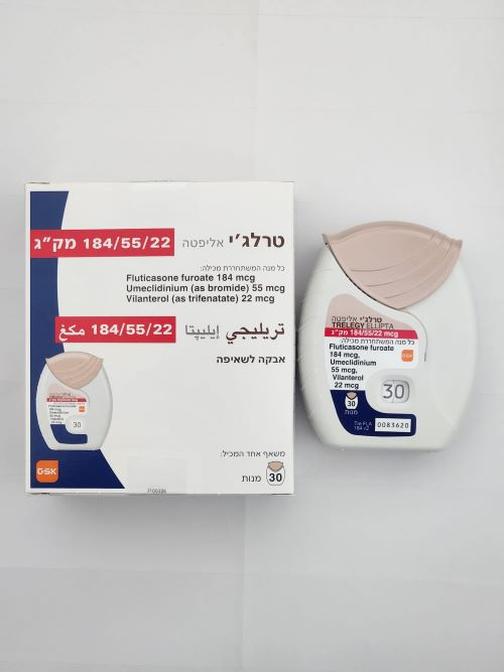Quest for the right Drug

טרלג'י אליפטה 184/55/22 מק"ג TRELEGY ELLIPTA 184 / 55 / 22 MCG (FLUTICASONE FUROATE, UMECLIDINIUM AS BROMIDE, VILANTEROL AS TRIFENATATE)
תרופה במרשם
תרופה בסל
נרקוטיקה
ציטוטוקסיקה
צורת מתן:
שאיפה : INHALATION
צורת מינון:
אין פרטים : POWDER FOR INHALATION PRE-DISPENSED
עלון לרופא
מינוניםPosology התוויות
Indications תופעות לוואי
Adverse reactions התוויות נגד
Contraindications אינטראקציות
Interactions מינון יתר
Overdose הריון/הנקה
Pregnancy & Lactation אוכלוסיות מיוחדות
Special populations תכונות פרמקולוגיות
Pharmacological properties מידע רוקחי
Pharmaceutical particulars אזהרת שימוש
Special Warning עלון לרופא
Physicians Leaflet
Adverse reactions : תופעות לוואי
4.8 Undesirable effects Summary of the safety profile The safety profile of Trelegy Ellipta (fluticasone furoate/umeclidinium/vilanterol) is based on data from one phase III clinical study in asthma (205715) and three phase III clinical studies and spontaneous reporting in COPD. Asthma The asthma study (205715) included 2,436 adult subjects inadequately controlled on their current treatment of combination therapy (ICS plus a LABA) who received fluticasone furoate/umeclidinium/vilanterol or an active comparator of fluticasone furoate/vilanterol for 24 to 52 week’s duration. COPD The most frequently reported adverse reactions are nasopharyngitis (7%), headache (5%) and upper respiratory tract infection (2%). Where adverse reaction frequencies differed between studies and populations, the higher frequency is reported. Tabulated list of adverse reactions Adverse reactions are listed by MedDRA system organ class. The frequency of adverse reactions is defined using the following convention: very common (≥1/10); common (≥1/100 to <1/10); uncommon (≥1/1,000 to <1/100); rare (≥1/10,000 to <1/1,000); very rare (<1/10,000) and not known (cannot be estimated from available data). System Organ Class Adverse reactions Frequency Infections and infestations Nasopharyngitis Very common Pneumonia* Common Upper respiratory tract infection Bronchitis Pharyngitis Rhinitis Sinusitis Influenza Candidiasis of mouth and throat Urinary tract infection Viral respiratory tract infection Immune system disorders Hypersensitivity reactions, including Rare anaphylaxis, angioedema, urticaria, and rash Metabolism and nutrition Hyperglycaemia Rare disorders Psychiatric disorders Anxiety Rare Nervous system disorders Headache Common Dysgeusia Uncommon Tremor Rare Eye disorders Vision blurred (see section 4.4) Uncommon Glaucoma Eye pain Intraocular pressure increased Rare Cardiac disorders Supraventricular tachyarrhythmia Uncommon Tachycardia Atrial fibrillation Palpitations Rare Respiratory, thoracic & Cough Common mediastinal disorders Oropharyngeal pain Dysphonia Gastrointestinal disorders Constipation Common Dry mouth Uncommon Musculoskeletal and Arthralgia Common connective tissue disorders Back pain Fractures Uncommon Muscle spasms Rare Renal and urinary disorders Urinary retention Rare Dysuria Description of selected adverse reactions *Pneumonia COPD In a total of 1810 patients with advanced COPD (mean post-bronchodilator screening FEV1 45% of predicted, standard deviation (SD) 13%), 65% of whom had experienced a moderate/severe COPD exacerbation in the year prior to study entry (study CTT116853), there was a higher incidence of pneumonia events reported up to 24 weeks in patients receiving Trelegy Ellipta (20 patients, 2%) than in patients receiving budesonide/formoterol (7 patients, <1%). Pneumonia which required hospitalisation occurred in 1% of patients receiving Trelegy Ellipta and <1% of patients receiving budesonide/formoterol up to 24 weeks. One fatal case of pneumonia was reported in a patient who received Trelegy Ellipta. In the subset of 430 patients treated for up to 52 weeks, the incidence of pneumonia events reported in both Trelegy Ellipta and budesonide/formoterol arms was equal at 2%. The incidence of pneumonia with Trelegy Ellipta is comparable with that observed in the fluticasone furoate/vilanterol (FF/VI) 100/25 arm of FF/VI clinical studies in COPD. In a 52-week study, with a total of 10355 patients with COPD and a history of moderate or severe exacerbations within the prior 12 months (mean post-bronchodilator screening FEV1 46% of predicted, SD 15%) (study CTT116855), the incidence of pneumonia was 8% (317 patients) for Trelegy Ellipta (n = 4151), 7% (292 subjects) for fluticasone furoate/vilanterol (n = 4134), and 5% (97 subjects) for umeclidinium/vilanterol (n = 2070). Fatal pneumonia occurred in 12 of 4151 patients (3.5 per 1000 patient- years) receiving Trelegy Ellipta, 5 of 4134 patients (1.7 per 1000 patient-years) receiving fluticasone furoate/vilanterol, and 5 of 2070 patients (2.9 per 1000 patient-years) receiving umeclidinium/vilanterol. Asthma In patients with asthma (study 205715) treated up to 52 weeks, the incidence of pneumonia was 1% (5 of 406 patients) for fluticasone furoate/umeclidinium/vilanterol 92/55/22 micrograms and <1% (4 of 408 patients) for fluticasone furoate/umeclidinium/vilanterol 184/55/22 micrograms. The incidence of pneumonia was 2% in the fluticasone furoate/vilanterol 92/22 micrograms (7 of 407 patients) and fluticasone furoate/vilanterol 184/22 micrograms (7 of 406 patients) groups. The incidence of pneumonia events requiring hospitalisation was similar in the fluticasone furoate/umeclidinium/vilanterol and fluticasone furoate/vilanterol groups (<1% for all groups). There were no fatal pneumonia events. Reporting of suspected adverse reactions Reporting suspected adverse reactions after authorisation of the medicinal product is important. It allows continued monitoring of the benefit/risk balance of the medicinal product. Any suspected adverse events should be reported to the Ministry of Health according to the National Regulation by using an online form https://sideeffects.health.gov.il/. Additionally, you should also report to GSK Israel (il.safety@gsk.com).

פרטי מסגרת הכללה בסל
א. מחלת ריאות חסימתית כרונית (COPD – Chronic Obstructive Pulmonary Disease). ב. טיפול אחזקה בחולים בגירים עם אסטמה שעונים על כל אלה:1. מטופלים במינון גבוה בטיפול משולב של קורטיקוסטרואידים בשאיפה (ICS) ותרופות ממשפחת ה-Long acting beta agonists (LABA).2. חוו לפחות החמרה (exacerbation) אחת של מחלתם בשנה האחרונה שחייבה טיפול בסטרואידים סיסטמיים.
שימוש לפי פנקס קופ''ח כללית 1994
לא צוין
תאריך הכללה מקורי בסל
16/01/2019
הגבלות
תרופה מוגבלת לרישום ע'י רופא מומחה או הגבלה אחרת
מידע נוסף
עלון מידע לצרכן
08.03.22 - עלון לצרכן אנגלית 28.08.22 - עלון לצרכן עברית 08.03.22 - עלון לצרכן ערבית 02.11.22 - עלון לצרכן אנגלית 02.11.22 - עלון לצרכן עברית 02.11.22 - עלון לצרכן ערבית 07.06.23 - עלון לצרכן אנגלית 07.05.23 - עלון לצרכן עברית 07.06.23 - עלון לצרכן ערבית 25.10.23 - עלון לצרכן עברית 25.12.23 - עלון לצרכן אנגלית 25.12.23 - עלון לצרכן עברית 25.12.23 - עלון לצרכן ערבית 10.11.24 - עלון לצרכן עברית 20.02.22 - החמרה לעלון 28.08.22 - החמרה לעלון 12.09.22 - החמרה לעלון 07.05.23 - החמרה לעלון 25.10.23 - החמרה לעלון 10.11.24 - החמרה לעלוןלתרופה במאגר משרד הבריאות
טרלג'י אליפטה 184/55/22 מק"ג